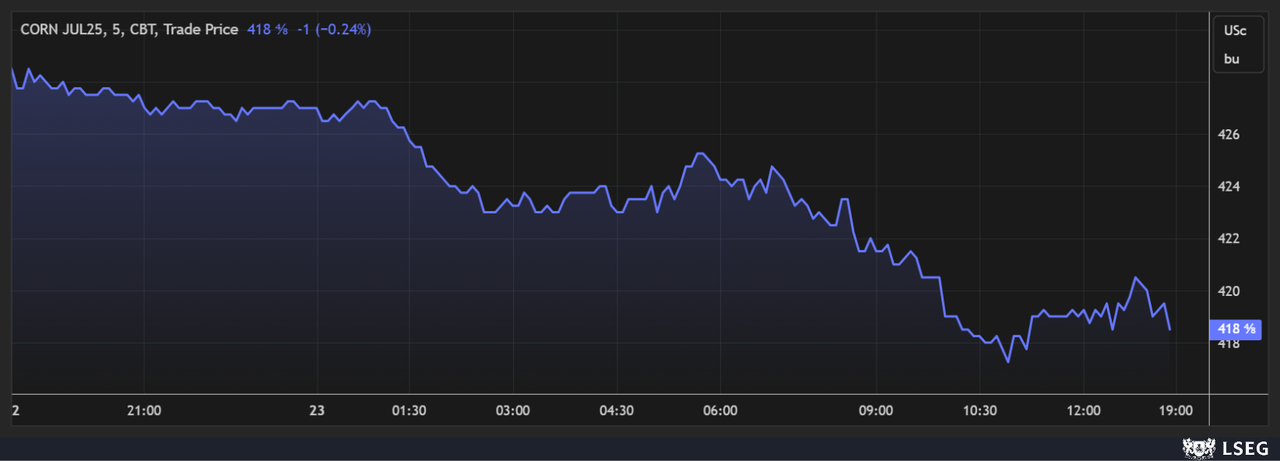Don’t miss the latest market commentary from the Farm Futures team. Sign up for the complimentary morning and afternoon market newsletters!
Strife in the Middle East often bleeds into the grain markets, and today’s price moves proved to be the rule rather than the exception. After weekend bombings of Iranian nuclear facilities, the country is making moves to close the Strait of Hormuz, which will likely cause a spike in freight rates and hinder the movement of grain and other commodities in some areas. As a result, corn, soybean and wheat prices all stumbled lower to start the week.
Plenty of rain is headed for parts of the upper Midwest later this week, with some fields set to gather another 2” or more between Tuesday and Friday, per the latest 72-hour cumulative precipitation map from NOAA. Later on, NOAA’s new 8-to-14-day outlook predicts seasonally warm, wet weather for most of the Midwest and Plains between June 30 and July 6.
On Wall St., the Dow climbed 243 points higher in afternoon trading to 42,450 as investors watched closely for potential retaliation from Iran after U.S.-led bombings of its nuclear facilities over the weekend. Energy futures suffered heavy blowback on the news, meantime, with crude oil slumping nearly 7% lower to $68 per barrel. Gasoline stumbled almost 5% lower. The U.S. Dollar softened moderately.
On Friday, commodity funds were net buyers of soymeal (+1,500) contracts but were net sellers of corn (-6,000), soybeans (-4,000), soyoil (-3,000) and CBOT wheat (-1,000).
Corn prices down on geopolitical tensions
Fresh fighting in the Middle East (initiated by the United States, even!) led to heavy losses following on a round of technical selling on Monday. July futures tumbled 10.25 cents lower to $4.1850, with September futures down 7.75 cents to $4.1775.

Corn spot basis bids were steady to mixed after tracking as much as a penny lower at an Iowa processor and as much as 2 cents higher at an Iowa ethanol plant on Monday.
Corn export inspections reached 58.1 million bushels. That was moderately lower than the prior week’s volume but still stayed on the higher end of analyst estimates, which ranged between 47. 2 million and 63.0 million bushels. Mexico was the No. 1 destination, with 13.6 million bushels. Cumulative totals for the 2024-25 marketing year remain well above last year’s pace, reaching 2.108 billion bushels.
Prior to Monday afternoon’s crop progress report from USDA, analysts expect 2025 corn plantings to be effectively complete, with 72% of the crop rated in good-to-excellent condition through June 22. Individual trade guesses ranged between 70% and 74%.
Brazil’s second corn crop harvest is off to a sluggish start so far after reaching 13% completion through June 19. That’s up from 5.2% versus the prior week but well below year-ago totals of 34% so far. Brazilian consultancy AgRural cites excessive humidity for slowing fieldwork in some areas.
Algeria issued an international tender to purchase up to 9.4 million bushels of animal feed corn from optional origins that closes on Tuesday. The grain is for shipment during the second half of July.
Corn settlements on Friday were for 409,120 contracts.
Soybean prices suffered moderate technical setback
Prices shifted into the red with a broad range of other commodities following a round of technical selling on Monday. July and August futures each fell 10 cents lower to settle at $10.58 and $10.6150, respectively.

Soybean spot basis bids trended a penny lower at an Ohio elevator and 3 cents higher at an Indiana processor while holding steady elsewhere across the central U.S. on Monday.
Soybean export inspections eased slightly lower week-over-week, only reaching 7.1 million bushels. That was also below the entire set of analyst estimates, which ranged between 7.3 million and 16.5 million bushels. Germany was the No. 1 destination, with 2.3 million bushels. Cumulative totals for the 2024-25 marketing year are still trending moderately ahead of last year’s pace, with 1.676 billion bushels.
Ahead of this afternoon’s crop progress report from USDA, analysts expect 2025 soybean plantings to move from 93% a week ago up to 97% through Sunday. Quality ratings are expected to shift one point higher, with 67% of the crop in good-to-excellent condition. Individual trade guesses ranged between 65% and 68%.
Soybean settlements on Friday were for 310,852 contracts.
Wheat prices suffered heavy blowback on Monday
Prices faced significant cuts following an ample round of technical selling today. July Chicago SRW futures stumbled 14.25 cents to $5.5350, July Kansas City HRW futures lost 12.25 cents to $5.51, and July MGEX spring wheat futures fell 10.25 cents to $6.2850.

Wheat export inspections eroded moderately lower after only reaching 9.4 million bushels last week. That was also on the very low end of analyst estimates, which ranged between 9.2 million and 18.4 million bushels. Japan was the No. 1 destination, with 3.0 million bushels. Cumulative totals for the 2025-26 marketing year are slightly below last year’s pace so far after reaching 31.0 million bushels.
Prior to Monday afternoon’s crop progress report from USDA, analysts expect to see winter wheat harvest move from 10% completion a week ago up to 20% through June 22. Quality ratings are expected to hold steady, with 52% of the crop in good-to-excellent condition.
Russian consultancy Sovecon estimates the country’s wheat exports at 44.1 million bushels in June, bouncing back from a seasonal low of 33.1 million bushels in May. Russia is the world’s top wheat exporter.
Egypt has imported 180.0 million bushels of wheat, 165.3 million bushels of corn and 2.2 million metric tons of soyoil so far in 2025, according to the latest report from the country’s agriculture ministry.
Bangladesh received multiple offers in its international tender to purchase 1.8 million bushels of wheat from optional origins that closed earlier today. The grain is for shipment within 50 days after contracts are signed.
CBOT wheat settlements on Friday were for 170,158 contracts.